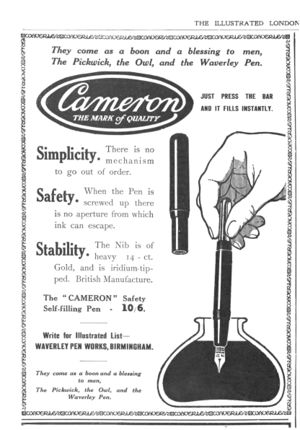Differenze tra le versioni di "Cameron/en"
(Creata pagina con "{{Infobox_Marca|Cameron}}</noinclude> thumb|A 1916 advertising") |
|||
| (31 versioni intermedie di 2 utenti non mostrate) | |||
| Riga 1: | Riga 1: | ||
| − | <noinclude>{{ | + | <noinclude>{{Infobox_Brand|Cameron}}</noinclude> |
[[Image:1916-09-Cameron.jpg|thumb|A 1916 advertising]] | [[Image:1916-09-Cameron.jpg|thumb|A 1916 advertising]] | ||
| − | + | The company's origins date back to the activity of Nisbet MacNiven that in [[1770]] founded a factory in Balerno, near Edinburgh, the city where activities on stationery production were transferred in [[1788]]. In [[1840]] John and Donald Cameron joined the company that became the ''MacNiven & Cameron Ltd.'' ''Duncan Cameron'' is credited with the design of the [[Waverley nib|''Waverley'' nib]] produced by ''[[Gillott]]'' since [[1864]] and roughly until the mid-70s of the 19th century. The company acquired a factory in Birmingham in [[1900]] and continued to produce nibs working in the stationery products market up to the closure of the factory in [[1964]]. | |
| − | + | The company entered the fountain pens market in the early 1900s (at least since [[1907]], as evidenced by this [[:File:1907-0x-Waverley-FountainPen.jpg|advertisement]] in the ''Strand Magazine''), repurposing a fountain pen with a [[Waverley nib|''Waverley'' nib]], covered by a patent from the same year ({{Cite patent|GB|190708313}}) named ''"[[Waverley Fountain Pen]]"''. The same advertisement shows that the company is headquartered in London with branches in Glasgow, Edinburgh and Paris.<ref>The company is cited by Lambrou for producing ''[[Waverley]]'' pens, but the name appears to have been used initially only for the models named ''[[Waverley Fountain Pen]]'', because of the eponymous type of nib, and not as a stand-alone brand.</ref> | |
| − | + | The company began marketing pens under its own name from about [[1916]], as evidenced by the advertisement on the side, with the invention of a special tweezer filling system (patent {{Cite patent|GB|101241}} of the same year), which were called ''"[[Cameron Safety Self Filler]]"''. These pens were made in different sizes, and, echoing the feature of the earlier ''"[[Waverley Fountain Pen]]"'' were also characterized by the possibility of mounting different [[Tipologie pennini Cameron|special nib]] derived directly from the equivalents popular in the world of dip nibs. | |
| − | == | + | The same pens were distributed in France at the end of World War I from ''Kirbie, Bird C.'' based in Rue Auber, 5 in Paris, with the name ''SAR Cameron'' (where however SAR is nothing more than an acronym for ''Safety Auto Remplissage''). The company apparently remained active until [[1964]], even if someone is reporting an earlier end of production. |
| − | * http://www.zianet.com/jmcdgwin/MacNCam.htm | + | |
| − | * http://kamakurapens.invisionzone.com/index.php?showtopic=741 | + | ==External references== |
| + | * [https://en.wikipedia.org/wiki/Macniven_and_Cameron] Page about the company on Wikipedia | ||
| + | * [https://www.gracesguide.co.uk/MacNiven_and_Cameron] Page about the company on Grace Guide | ||
| + | * [http://web.archive.org/web/20090311005449/http://www.zianet.com:80/jmcdgwin/MacNCam.htm] Page about the company, disappeared from current site pages | ||
| + | * [http://kamakurapens.invisionzone.com/index.php?showtopic=741] Unreachable link on the discontinued Kamakura Pens site, remains for reference | ||
<noinclude> | <noinclude> | ||
| − | == | + | ==Notes== |
<references/> | <references/> | ||
| − | |||
| − | + | {{CategorizeBrand|Inghilterra|Secondary brand}}</noinclude> | |
| − | |||
| − | |||
Versione attuale delle 02:40, 14 mar 2024
| Cameron |
|---|
| Brand pages |
| Brand advertising |
| Brand photos |
| Patents |
The company's origins date back to the activity of Nisbet MacNiven that in 1770 founded a factory in Balerno, near Edinburgh, the city where activities on stationery production were transferred in 1788. In 1840 John and Donald Cameron joined the company that became the MacNiven & Cameron Ltd. Duncan Cameron is credited with the design of the Waverley nib produced by Gillott since 1864 and roughly until the mid-70s of the 19th century. The company acquired a factory in Birmingham in 1900 and continued to produce nibs working in the stationery products market up to the closure of the factory in 1964.
The company entered the fountain pens market in the early 1900s (at least since 1907, as evidenced by this advertisement in the Strand Magazine), repurposing a fountain pen with a Waverley nib, covered by a patent from the same year (nº GB-190708313) named "Waverley Fountain Pen". The same advertisement shows that the company is headquartered in London with branches in Glasgow, Edinburgh and Paris.[1]
The company began marketing pens under its own name from about 1916, as evidenced by the advertisement on the side, with the invention of a special tweezer filling system (patent nº GB-101241 of the same year), which were called "Cameron Safety Self Filler". These pens were made in different sizes, and, echoing the feature of the earlier "Waverley Fountain Pen" were also characterized by the possibility of mounting different special nib derived directly from the equivalents popular in the world of dip nibs.
The same pens were distributed in France at the end of World War I from Kirbie, Bird C. based in Rue Auber, 5 in Paris, with the name SAR Cameron (where however SAR is nothing more than an acronym for Safety Auto Remplissage). The company apparently remained active until 1964, even if someone is reporting an earlier end of production.
External references
- [1] Page about the company on Wikipedia
- [2] Page about the company on Grace Guide
- [3] Page about the company, disappeared from current site pages
- [4] Unreachable link on the discontinued Kamakura Pens site, remains for reference
Notes
- ↑ The company is cited by Lambrou for producing Waverley pens, but the name appears to have been used initially only for the models named Waverley Fountain Pen, because of the eponymous type of nib, and not as a stand-alone brand.
